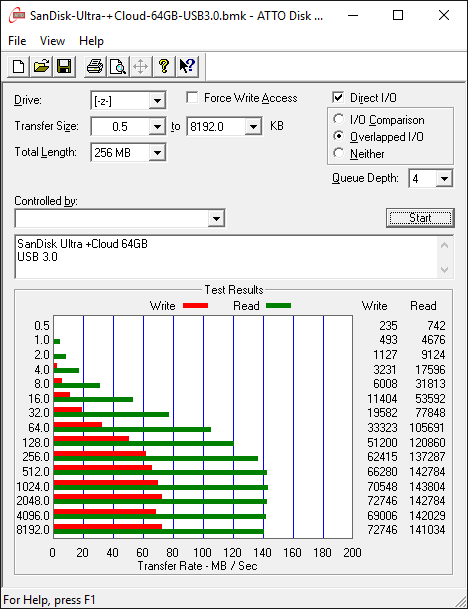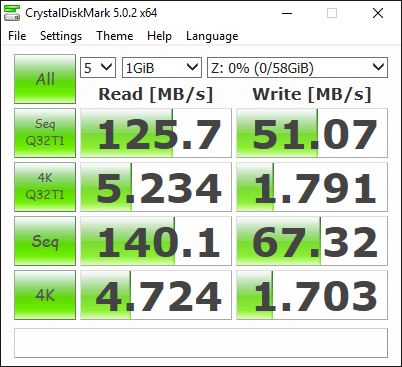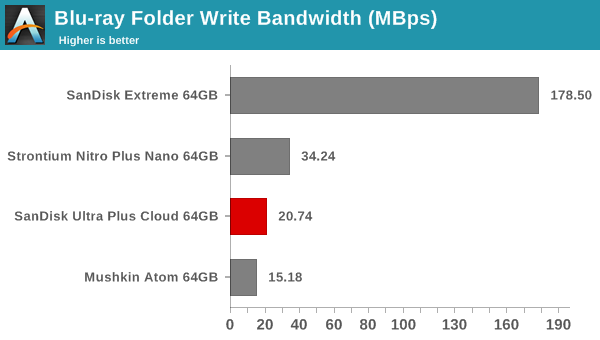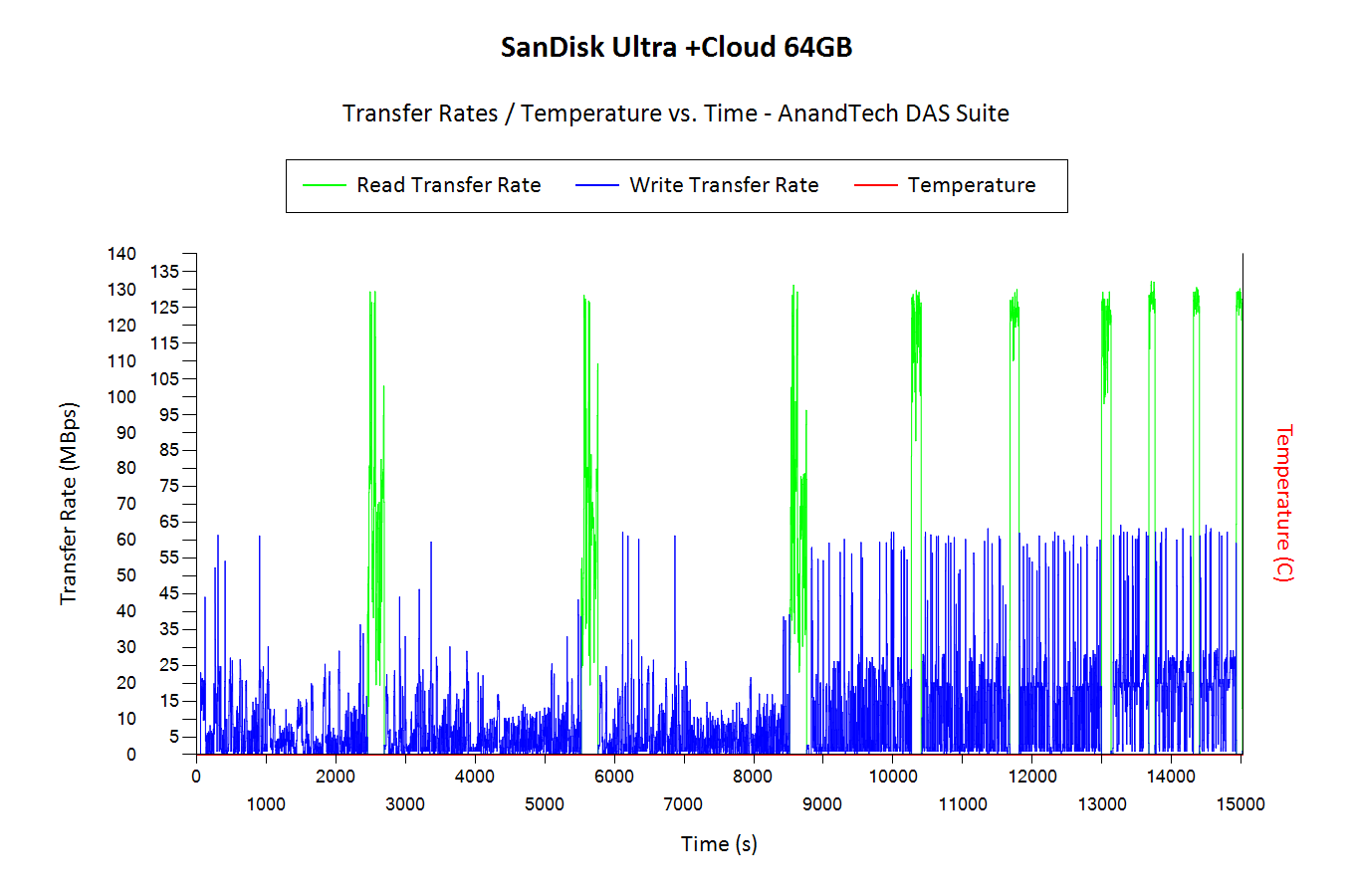SanDisk Ultra +Cloud 64GB + 64GB Flash Drive Review
by Ganesh T S on February 18, 2016 7:30 AM EST- Posted in
- Storage
- USB 3.0
- Flash Drive
- SanDisk
- Cloud Storage
Direct-Attached Storage Performance
Evaluation of DAS units on Windows is done with the testbed outlined in the table below. For devices with USB 3.0 connections (such as the SanDisk Ultra +Cloud that we are considering today), we utilize the USB 3.0 port directly hanging off the PCH.
| AnandTech DAS Testbed Configuration | |
| Motherboard | Asus Z97-PRO Wi-Fi ac ATX |
| CPU | Intel Core i7-4790 |
| Memory | Corsair Vengeance Pro CMY32GX3M4A2133C11 32 GB (4x 8GB) DDR3-2133 @ 11-11-11-27 |
| OS Drive | Seagate 600 Pro 400 GB |
| Optical Drive | Asus BW-16D1HT 16x Blu-ray Write (w/ M-Disc Support) |
| Add-on Card | Asus Thunderbolt EX II |
| Chassis | Corsair Air 540 |
| PSU | Corsair AX760i 760 W |
| OS | Windows 8.1 Pro |
| Thanks to Asus and Corsair for the build components | |
The full details of the reasoning behind choosing the above build components can be found here. The list of DAS units used for comparison purposes is provided below.
- SanDisk Ultra Plus Cloud 64GB
- Mushkin Atom 64GB
- SanDisk Extreme 64GB
- Strontium Nitro Plus Nano 64GB
Synthetic Benchmarks - ATTO and Crystal DiskMark
SanDisk claims read and write speeds of more than 100 MBps and around 50 MBps respectively, and these are backed up by the ATTO benchmarks provided below. Unfortunately, these access traces are not very common in real-life scenarios.

CrystalDiskMark, despite being a canned benchmark, provides a better estimate of the performance range with a selected set of numbers. As evident from the screenshot below, the performance can dip to as low as 1.7 MBps for 4K random writes (understandably not the typical usage scenario for UFDs)

Benchmarks - robocopy and PCMark 8's Storage Bench
Our testing methodology for DAS units also takes into consideration the usual use-case for such devices. The most common usage scenario is transfer of large amounts of photos and videos to and from the unit. The minor usage scenario is importing files directly off the DAS into a multimedia editing program such as Adobe Photoshop.
In order to tackle the first use-case, we created three test folders with the following characteristics:
- Photos: 15.6 GB collection of 4320 photos (RAW as well as JPEGs) in 61 sub-folders
- Videos: 16.1 GB collection of 244 videos (MP4 as well as MOVs) in 6 sub-folders
- BR: 10.7 GB Blu-ray folder structure of the IDT Benchmark Blu-ray (the same that we use in our robocopy tests for NAS systems)






For the second use-case, we have traditionally used PC Mark 8's storage bench. However, our recent update to the benchmark program has rendered comparisons with earlier results invalid. The storage workload involves games as well as multimedia editing applications. The command line version allows us to cherry-pick storage traces to run on a target drive. We chose the following traces.
- Adobe Photoshop (Light)
- Adobe Photoshop (Heavy)
- Adobe After Effects
- Adobe Illustrator
Usually, PC Mark 8 reports time to complete the trace, but the detailed log report has the read and write bandwidth figures which we present in our performance graphs. Note that the bandwidth number reported in the results don't involve idle time compression. Results might appear low, but that is part of the workload characteristic. The Photoshop light editing access traces benchmarked with reads at 3.86 MBps and writes at 16.35 MBps. The heavy access trace benchmarked at 5.14 MBps reads and 21.23 MBps writes. The After Effects access trace benchmarked with reads at 4.41 MBps and writes at 2.83 MBps. The Illustrator reads were at 9.68 MBps and writes at 15.48 MBps.
Performance Consistency
Yet another interesting aspect of these types of units is performance consistency. Aspects that may influence this include thermal throttling and firmware caps on access rates to avoid overheating or other similar scenarios. This aspect is an important one, as the last thing that users want to see when copying over, say, 50 GB of data to the flash drive, is the transfer rate going to USB 2.0 speeds. In order to identify whether the drive under test suffers from this problem, we instrumented our robocopy DAS benchmark suite to record the flash drive's read and write transfer rates while the robocopy process took place in the background. For supported drives, we also recorded the internal temperature of the drive during the process. The graphs below show the speeds observed during our real-world DAS suite processing. The first three sets of writes and reads correspond to the photos suite. A small gap (for the transfer of the videos suite from the primary drive to the RAM drive) is followed by three sets for the next data set. Another small RAM-drive transfer gap is followed by three sets for the Blu-ray folder.
An important point to note here is that each of the first three blue and green areas correspond to 15.6 GB of writes and reads respectively. Throttling, if any, is apparent within the processing of the photos suite itself. It is evident that there is no throttling at play here. The write transfer rates in the 'Photos' data set is quite low - almost USB 2.0 speeds, though these improve a bit for the larger files in the other data set. The instantaneous spikes to 55 - 60 MBps for UFD writes in the Videos and Blu-ray folder transfers regularly seem to indicate some sort of fast first-level memory (SLC cache, possibly) in the flash drive.











21 Comments
View All Comments
stephenbrooks - Thursday, February 18, 2016 - link
I was hoping there'd be something clever, like the USB drive always mirrors the cloud files when it can, so if you go somewhere without internet you can get the files off the USB. But doesn't look like it.Bladen - Thursday, February 18, 2016 - link
I really, really hope that they release these as is in Australia...So the ACCC can fine them for misleading advertising!
valinor89 - Thursday, February 18, 2016 - link
I have been testing one of those reversible USB to micro USB cables and I wish we had more devices with reversible USB connectors.Gothmoth - Thursday, February 18, 2016 - link
sorry im not stupid enuff to buy into this....darkfalz - Friday, February 19, 2016 - link
I don't like this gimmick. It's bad enough with Netbooks and the like who say 200 GB* storage (with most of that on the cloud).That being said SanDisk is my goto company for thumb drives and SD cards - only ever been let down by their cheapo "Cruzer Blade" range.
rxzlmn - Friday, February 19, 2016 - link
What is the drive formatted in and can you reformat it without crippling it? I bought a Sandisk Ultra a while ago, re-formatted since it came with FAT32, and it became ridiculously slow when writing (5MByte/sec tops). After googling the issue, I found that once re-formatted that behaviour is sort of irreversible. Tried a bunch of different formatting tools and settings, nothing worked. So the Sandisk Ultra is now slower than my 10 year old USB2 drives.ganeshts - Sunday, February 21, 2016 - link
All our benchmarks are processed with the drive in exFAT format, unless noted otherwise.Grydelåg - Wednesday, February 24, 2016 - link
Rxzimm the performance is cluster size dependent so you have to find the right "block" size for the flash drive you are using and format it with that.But be aware that this must be balanced against the number of small files you have on your drive why ex a 1k file will take 8k space if cluster size is 8k(B)cratervalley - Thursday, February 25, 2016 - link
For me the lynchpin for a cloud provider is trust. As an ex-customer of Bitcasa in 2013 they cancelled my plan that was $99 a year, unless I paid $999 a year, and gave me only 2 weeks to move terabytes of data at insanely low transfer rates. Even after my account was cancelled they continued to bill me and I had to dispute the charge with my credit card provider. I would put zero trust in this company, a quick Google or Twitter search will indicate these guys have no idea what they are doing. They are an Amazon S3 reseller positioning their product now as a corporate-level enterprise product and they never even supported two factor authentication even after numerous customer requests.shilpamalhotra - Wednesday, May 4, 2016 - link
I knew a few of them from before, but this list is very helpful.. It will take some time to browse through. Yep, will bookmark it.Feel Free To Surf My Website - <a href="http://www.gurgaonfairy.com">Female Escorts in Gurgaon</a>